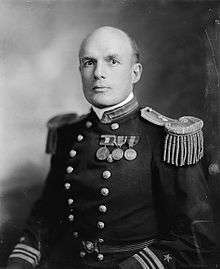Thomas Tingey Craven (US Navy admiral)
Thomas Tingey Craven (8 July 1873 in Vallejo, California – 5 April 1950 in St. Albans, New York) was a United States naval officer with service in World War I and World War II and rose to the rank of vice admiral.
Thomas Tingey Craven | |
|---|---|
 Lieutenant Commander Thomas Tingey Craven in service dress blue uniform. | |
| Born | July 8, 1873 Vallejo, California |
| Died | April 5, 1950 (aged 76) St. Albans, New York |
| Allegiance | |
| Service/ | |
| Years of service | 1896–1937,1942–1946 |
| Rank | |
| Commands held | Director of Naval Communications |
| Battles/wars | Philippine–American War World War I World War II |
| Awards | Navy Distinguished Service Medal |
Biography
He was a son of Henry Smith Craven, a United States Navy officer and engineer and the grandson of his namesake, Thomas Tingey Craven (1808–1887) and great-grandson of Commodore Thomas Tingey (1750–1829).
Craven graduated from the United States Naval Academy in 1896. His first assignment after graduation was to the newly commissioned battleship USS Massachusetts (BB-2), where he served as a naval cadet. (Prior to the first world war, graduates of the naval academy were required to serve two years at sea prior to being commissioned.) Craven was commissioned as an ensign on 6 May 1898. During the Spanish–American War he served on the collier USS Scindia which delivered coal to recently captured Guantanamo Bay in Cuba in June 1898. He married Antoinette Merritt in 1901.
In 1908, Craven was stationed aboard the battleship USS South Carolina (BB-26) assigned duties as the ship's gunnery officer. In 1916, Thomas T. Craven was given command of the gunboat Sacramento (PG-19) which he commanded throughout World War I until 1918.
In 1919 while serving as the director of Naval Aviation, Tingey ordered the USS Jupiter (AC-3), a collier, to be converted into the U.S. Navy's first dedicated aircraft carrier which was renamed, USS Langley (CV-1). In the aftermath of the Honda Point Disaster in September 1923, Admiral Tingey defended Captain Edward H. Watson, Commanding Officer of Destroyer Squadron 11, during the courts martial proceedings.[1]
During the remainder of his naval career, Craven commanded Destroyer Squadron 15, was the Director of Naval Communications, commanded Great Lakes Naval Training Station, the Yangtze Patrol in China, Battleship Division One and served as the Commandant of the Thirteenth Naval District in Bremerton, Washington prior to retiring from active duty in 1937.
Following the United States' entrance into World War II, Vice Admiral Craven was recalled to active duty serving as superintendent of the New York Maritime Academy at Fort Schuyler, NY until 1946, when he was succeeded by Vice admiral Herbert F. Leary.
References
- Craven, Thomas T. (Thomas Tingey), 1873-1950. DLC. "Archived copy". Archived from the original on 2013-12-12. Retrieved 2013-12-12.CS1 maint: archived copy as title (link)
External links
- "Thomas Tingey CRAVEN". Whittlesey-WhittelseyFamilyHistory. Retrieved 12 December 2013.
- "Thomas T. Craven papers, 1842-1969,". Library of Congress. Retrieved 12 December 2013.
- "Craven, Thomas T. (Thomas Tingey), 1873-1950". University of Virginia: SNAC: Social Networks and Archival Context Project. Archived from the original on 12 December 2013. Retrieved 12 December 2013.
- "Thomas Tingey Craven, 1873-1950". Find A Grave. Retrieved 12 December 2013.
- Thomas Tingey Craven Memoirs, 1897-1953 (bulk 1942-1953), MS 530 held by Special Collections & Archives, Nimitz Library at the United States Naval Academy